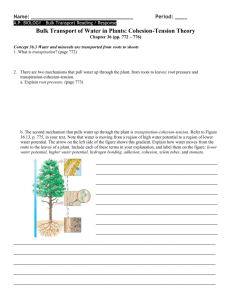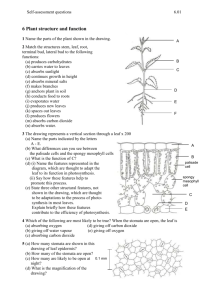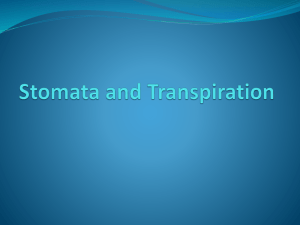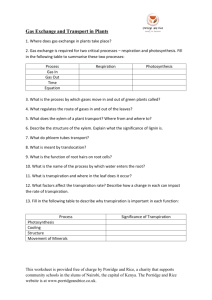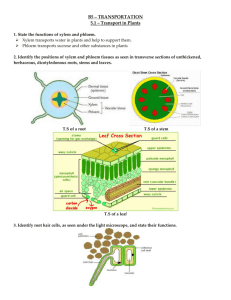Plant Transport & Food storage
advertisement
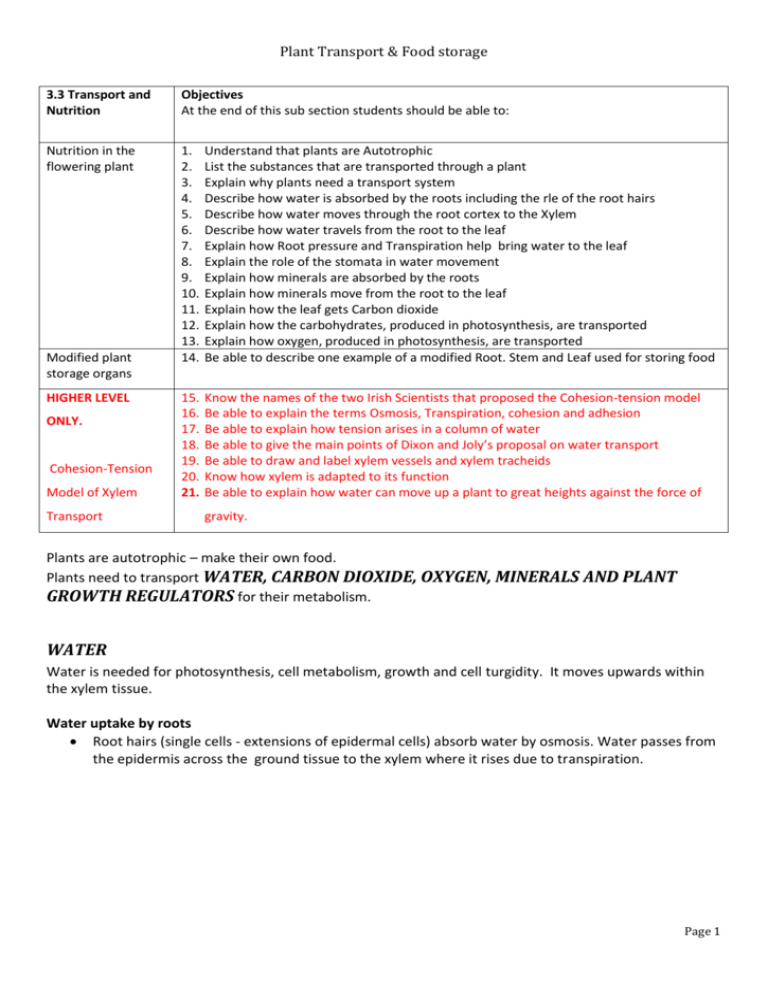
Plant Transport & Food storage 3.3 Transport and Nutrition Objectives At the end of this sub section students should be able to: Nutrition in the flowering plant 1. 2. 3. 4. 5. 6. 7. 8. 9. 10. 11. 12. 13. 14. Understand that plants are Autotrophic List the substances that are transported through a plant Explain why plants need a transport system Describe how water is absorbed by the roots including the rle of the root hairs Describe how water moves through the root cortex to the Xylem Describe how water travels from the root to the leaf Explain how Root pressure and Transpiration help bring water to the leaf Explain the role of the stomata in water movement Explain how minerals are absorbed by the roots Explain how minerals move from the root to the leaf Explain how the leaf gets Carbon dioxide Explain how the carbohydrates, produced in photosynthesis, are transported Explain how oxygen, produced in photosynthesis, are transported Be able to describe one example of a modified Root. Stem and Leaf used for storing food 15. 16. 17. 18. 19. 20. 21. Know the names of the two Irish Scientists that proposed the Cohesion-tension model Be able to explain the terms Osmosis, Transpiration, cohesion and adhesion Be able to explain how tension arises in a column of water Be able to give the main points of Dixon and Joly’s proposal on water transport Be able to draw and label xylem vessels and xylem tracheids Know how xylem is adapted to its function Be able to explain how water can move up a plant to great heights against the force of Modified plant storage organs HIGHER LEVEL ONLY. Cohesion-Tension Model of Xylem Transport gravity. Plants are autotrophic – make their own food. Plants need to transport WATER, CARBON DIOXIDE, OXYGEN, MINERALS AND PLANT GROWTH REGULATORS for their metabolism. WATER Water is needed for photosynthesis, cell metabolism, growth and cell turgidity. It moves upwards within the xylem tissue. Water uptake by roots Root hairs (single cells - extensions of epidermal cells) absorb water by osmosis. Water passes from the epidermis across the ground tissue to the xylem where it rises due to transpiration. Page 1 Plant Transport & Food storage T.S. root – pathway of water Transport of water is caused by root pressure and transpiration. Root pressure is the forced upward movement of water and mineral salts from the root up through the stem. Transpiration: The loss of water vapour from a plant, mainly through the stomata of the leaves. Control of transpiration 1. Cuticle: a thick cuticle reduces transpiration. 2. Stomata: Mostly on lower surface of leaf. Helps to reduce water loss by transpiration because rate of evaporation is higher on the upper surface. 3. Stomatal opening /closing e.g. open as light intensity increases and close at night - this reduces water loss. Environmental conditions can cause stomata to close during the day – if a plant loses too much water and high temperatures. Page 2 Plant Transport & Food storage Stomatal opening and closing: Each stoma is surrounded by two guard cells. The guard cells change shape and so open and close the stoma. When water enters the guard cells they swell and buckle outwards leaving a gap between them. When water leaves the guard cells they shrink and the gap between them closes. Carbon dioxide levels affect the opening and closing of stomata. High levels of carbon dioxide cause the stomata to close, it is a controlling factor in gaseous exchange. At night there is no photosynthesis, respiration is occurring, high levels of carbon dioxide build up in the air spaces causing the stomata to close Day time photosynthesis is occurring, carbon dioxide is used up, so low levels of carbon dioxide present in the air spaces and the stomata open (Note: - use the word secretion or loss rather than excretion when referring to the loss of gases from a plant) MINERALS Needed for synthesizing plant components e.g. calcium, magnesium, nitrates, phosphates and potassium ions. They enter root hairs, dissolved in water, by active transport and are transported by xylem. CARBON DIOXIDE Needed for photosynthesis. Diffuses through stomata and air spaces. Obtained from respiration in cells and atmosphere. Page 3 Plant Transport & Food storage OXYGEN Obtained from photosynthesis and atmosphere. Diffuses through air spaces. Used for respiration. GLUCOSE Formed by photosynthesis. Used in respiration, stored as starch, translocated as sucrose in phloem sieve tubes (sap). GROWTH REGULATORS For coordination of plant responses. Move by diffusion and active transport. See notes on Plant Hormones Gas Exchange in Plants – Leaf, Stem, Stomata LEAF Carbon dioxide diffuses into the leaf through the stomata on the under surface of the leaf, it then moves through the intercellular air spaces to the mesophyll cells where it is used for photosynthesis. Photosynthesis produces glucose and oxygen, the oxygen diffuses out of the mesophyll cells into the air spaces and out of the leaf through the stomata. Water vapour also diffuses out of the leaf through the stomata – this loss is called transpiration. This movement of gases is called gaseous exchange. The air spaces help to increase the surface area for gas exchange inside a leaf. Page 4 Plant Transport & Food storage Adaptation of the Leaf for Gas Exchange Stomata - Allow gases to taken in and out of the leaf quickly Thin lamina (leaf blade) - short distance for CO2 to diffuse Large surface area Air spaces - diffusion of CO2 and O2 is faster than in liquid Moist tissue - necessary for transfer of gases in and out of cells STEM Normally the epidermis or bark on a stem is too thick to allow for gaseous exchange. Instead the lenticels are present, these are tiny openings found along the stem which allow oxygen inwards and carbon dioxide and water outwards (mainly for respiration, not photosynthesis). Page 5 Plant Transport & Food storage FOOD STORAGE ORGANS IN PLANTS Plants can change or modify their roots, stems and leaves to act as food storage organs. Perennials are plants that survive from one growing season to the next by storing food as starch. Modified Leaves (Bulbs) e.g. onion: Onion bulbs are edible, but daffodil and tulip bulbs are poisonous – prevents them from being eaten by organisms while in the ground. Other examples include cabbage and lettuce, as are the leaf stalks (petioles) of rhubarb and celery. Modified Stems: eg Potato Stem tubers are the swollen ends of underground stems e.g. potato. Page 6 Plant Transport & Food storage Modified Roots: eg Carrot e.g. carrot, turnip and sugar beet are swollen tap roots modified for food storage. Carrot HIGER LEVEL ONLY The cohesion – tension model of water transport in xylem (Dixon and Joly, Dublin 1895) Water moves up through a flowering plant partly by being pushed up by root pressure, but mostly by being pulled up due to transpiration. This model explains how water is transported up tall trees against the force of gravity. This model was first put forward by two Irish scientists – Dixon and Joly. Cohesion means similar molecules sticking together (water has a high cohesion). Adhesion means different molecules sticking together (water and xylem have a lower adhesion). Mechanism: 1. Water evaporates from the xylem into the air spaces of the leaf and eventually out into the air. 2. As transpiration pulls each water molecule out of the xylem, the next water molecule is pulled with it due their high cohesion. 3. When water molecules are pulled in this way the entire column is stretched i.e. the water is under tension. 4. This tension is transmitted down to the root xylem due to cohesion between water molecules. This tension is great enough to pull water up 150 metres! 5. The tension produced in the water column causes the xylem and hence the stem to become narrower during the day. To prevent xylem cells collapsing inwards each is strengthened with lignin. 6. When transpiration stops (night – stomata closed), the lack of tension allows the xylem to return to its original wider shape due to elasticity of their walls.. (Note: lignin prevents xylem cells from collapsing inwards) Page 7



